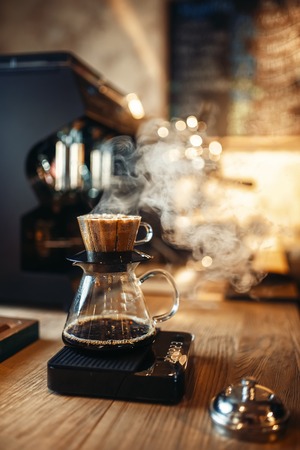Espresso in the British Home: A Brief Introduction
If you stroll through any city or town across the UK, it’s impossible to miss the warm glow of independent coffee shops nestled between centuries-old brickwork and modern glass facades. But increasingly, the true heart of Britain’s espresso revolution is beating within our own homes. No longer the exclusive domain of Italian cafes or the bustling high street, artisan coffee culture has quietly taken root in British households, reshaping morning rituals and elevating kitchen counters with gleaming espresso machines and a selection of single-origin beans. In this new era, understanding the science behind a proper espresso—how water quality, pressure, and temperature interact—is becoming just as essential as knowing where to find the best local roast. This growing appreciation for crafting café-quality coffee at home marks a subtle yet significant shift in how we engage with our daily brew, blending British pragmatism with a newfound passion for precision and flavour.
Water, the Unsung Hero: How UK Tap Water Shapes Your Coffee
When we muse on the perfect espresso, water rarely takes centre stage. Yet, for coffee lovers in the UK, it’s not just a backdrop—it’s a defining character. The tap water flowing through British homes is a nuanced blend of history, geology, and local quirks, each drop quietly sculpting the espresso in your cup. Unlike Italy’s mineral-balanced springs or the soft rainwater of Scandinavia, Britain’s regional water varies wildly—from chalky hardness in Kent to peaty softness in the Scottish Highlands.
The Role of Water Hardness in Espresso Extraction
Water hardness—essentially the concentration of calcium and magnesium ions—affects how well your espresso extracts flavours from ground coffee. Too hard, and your brew risks tasting flat or overly bitter. Too soft, and you might miss out on those rich, rounded notes that make espresso sing. Here’s a quick glance at how typical UK regions stack up:
| Region | Typical Hardness (mg/L CaCO3) | Espresso Impact |
|---|---|---|
| London & South East | 200–350 (Hard) | Can mute brightness; limescale risk for machines |
| North West England | 30–60 (Soft) | Lively acidity; gentler extraction |
| Scotland Highlands | <30 (Very Soft) | Delicate flavour clarity; may need mineral adjustment |
| Bristol & South West | 120–250 (Moderately Hard) | Smooth balance if tuned right |
The Local Nuances: More Than Just Hard or Soft
Taste a shot pulled with Brighton’s briny tap versus a pour from Manchester’s rain-fed reservoirs—you’ll discover subtle but palpable differences. Some cities impart faint mineral tangs, others add an earthy undertone. In Britain, even old pipes and Victorian plumbing can shape your morning cup, as trace metals and residual treatments sneak into the final flavour profile.
Navigating Your Own Tap Water for Espresso Bliss
If you’re chasing café-quality espresso at home, understanding your local tap water is key. Many British baristas swear by filtered or remineralised water to hit that sweet spot: not too hard, not too soft, but balanced enough to coax complexity from every bean. Next time you sip your homemade flat white or punchy double shot, raise a toast to the humble British tap—a quiet hero behind every great cup.

3. Pressure Matters: The Art and Physics Behind Espresso Machines
When it comes to pulling a proper espresso, pressure isn’t just a number on a dial—it’s the silent hand shaping every cup. In the UK, where our kitchens are sometimes compact but our coffee ambitions mighty, understanding how pressure works can turn a daily ritual into an act of artistry. At its heart, espresso is brewed under intense pressure—traditionally around 9 bars, which is about nine times the atmospheric pressure at sea level (think of it as the difference between a lazy canal and the gushing Thames after a storm). This pressure forces hot water through finely ground coffee, extracting those signature bold flavours and creating the crema—the velvety foam that crowns each shot.
But here’s where British homes come into play. Not all domestic machines are created equal; many budget-friendly or older models struggle to hit or maintain this golden 9-bar standard. Some might overshoot, others might limp along below par, leading to lacklustre body or thin crema—a bit like drinking a flat pint in a lukewarm pub. Enthusiasts know that too little pressure results in under-extraction: sourness, pale crema, and watery texture. Too much? Over-extraction, bitterness, and a burnt aftertaste that no amount of oat milk can rescue.
For city dwellers navigating retrofitted flats or listed Victorian terraces, water mains pressure can also affect your machine’s performance. A consistent, well-calibrated pump is key—this is why some baristas obsess over machines with adjustable settings or even invest in pressure gauges for their home set-up. It’s worth noting that UK tap water itself can subtly influence how your kit holds pressure; limescale build-up (a classic British headache) can restrict flow and reduce efficiency over time.
So next time you’re standing bleary-eyed before your home espresso machine, remember: the perfect cup isn’t just about beans or grind size. It’s about harnessing just enough force to coax out complexity without bruising those delicate notes—a daily experiment in physics, performed one satisfying shot at a time.
4. Temperature: Striking the British Balance
Espresso is as much a science as it is an art, and nowhere is this more apparent than in the delicate orchestration of temperature. In the UK, where the climate is famously moody—oscillating between chilly mornings and damp afternoons—achieving the ideal brewing temperature can feel like chasing a sunbeam through a London fog. But getting it right is vital: too hot, and your espresso veers into bitter, burnt territory; too cold, and you’re left with sourness that lingers longer than a Northern drizzle.
The Importance of Temperature Control
Water temperature directly influences how flavours are extracted from coffee grounds. The generally accepted sweet spot for brewing espresso sits between 90°C and 96°C (194°F to 205°F). This range allows for optimal extraction—balancing the acidity, sweetness, and body that define a truly exceptional shot. Yet, in many UK homes, central heating quirks or draughty kitchens can make maintaining this precision a real feat.
British Climate Considerations
The ambient temperature in British homes fluctuates with the seasons. In winter, colder kitchens can lower machine temperatures faster, while summer heatwaves (rare but memorable) might nudge them upwards. This variability means that even high-end home espresso machines must be coaxed into consistency—a challenge familiar to anyone who’s ever waited for a kettle to boil on a frosty morning.
Finding Your Espresso Sweet Spot
If you’re on a quest for consistency, start by understanding how your machine responds to your environment. Many baristas recommend pre-heating your espresso machine (and even your cups) during colder months to combat the chill. If you’re able to adjust brew temperatures manually, experiment within the recommended range to see what sings with your local water and chosen beans.
Temperature Ranges and Flavour Outcomes
| Temperature Range (°C) | Flavour Profile | Typical Outcome in UK Homes |
|---|---|---|
| Below 90°C | Sourness, Under-extracted | Common in unheated kitchens or quick start-ups on cold mornings |
| 90°C – 94°C | Balanced Acidity & Sweetness | Ideal range; achievable with pre-heating and stable machines |
| 95°C – 96°C | Bolder Body, Subtle Bitterness | Favoured for darker roasts or when seeking a richer mouthfeel |
| Above 96°C | Bitter, Burnt Notes | Risk during heatwaves or with poorly calibrated machines |
Navigating these nuances may require patience—and perhaps an extra jumper or two—but mastering temperature is fundamental to unlocking espresso’s full potential at home. By respecting both science and season, British coffee lovers can achieve that coveted balance: a shot of espresso that feels just right, no matter what the weather’s doing outside.
5. Common Home-Brew Challenges in the UK
If you’ve ever tried to pull a shot of espresso in a British kitchen, you’ll know it’s not always as simple as it looks on those glossy Italian coffee adverts. For starters, the UK’s famously hard water is both a blessing and a curse—rich in minerals that can enhance flavour, but also a notorious culprit for limescale build-up. In regions like London or Birmingham, kettles and espresso machines alike wage constant battle against chalky residue, which can muck up your machine’s inner workings and subtly sabotage your brew.
Pressure is another hurdle for the home barista. Many entry-level domestic espresso machines struggle to reach or maintain the consistent nine bars of pressure required for true espresso extraction. This can lead to shots that are watery or bitter—hardly the silky elixir you’re after. While some aficionados invest in higher-end kit or tinker with manual levers, most Brits make do with what they have, learning to coax the best out of their equipment with a bit of patience and trial-and-error.
Then there’s the eternal grind—literally. Finding a decent espresso grind in the UK is an art in itself. Supermarket pre-ground coffee is usually too coarse for espresso, while high-street grinders aren’t always dialled in for such precision. The result? A frustrating game of Goldilocks: too fine and your shot chokes; too coarse and it gushes through like weak tea. It’s no wonder many end up investing in a burr grinder just to hit that sweet spot between powder and gravel.
Temperature fluctuations in older British homes add another layer of complexity. Draughty kitchens and chilly mornings mean your water temperature might dip below the optimal 90-96°C before it even touches the coffee, sapping sweetness and body from your cup. The solution often involves pre-warming cups, running blank shots, or even draping a tea towel over your machine—a very British improvisation.
All these quirks combine to create a uniquely British espresso experience—part ritual, part challenge, but wholly satisfying when you finally nail that perfect shot amidst limescale and leaky windows.
6. Practical Tips for the British Espresso Enthusiast
If you’re seeking to master the art of espresso in your UK home, there’s a science—and a certain British pragmatism—to getting it just right. Let’s break down some actionable advice that taps into the unique characteristics of British water, domestic pressure quirks, and the nation’s temperamental weather.
Water Filtration: Navigating Hardness from London to Leeds
First, water quality. Much of the UK, especially in cities like London, deals with hard water—rich in minerals like calcium and magnesium. While these can add depth to your espresso, they also wreak havoc on machines. Invest in a reputable water filter jug or plumbed-in system; brands like Brita are household names here for good reason. For a more precise approach, consider using test strips to gauge your tap’s mineral content and tailor your filtration accordingly. Don’t forget regular descaling; limescale build-up is the silent killer of many a beloved Gaggia or Sage machine.
Pressure Calibration: Taming Domestic Machines
Many British homes rely on plug-and-play espresso makers, which sometimes struggle to hit—or maintain—the golden 9 bars of pressure needed for true espresso extraction. If you’re handy, look for machines with adjustable overpressure valves (OPVs), or consult your local repair shop (supporting the high street never goes out of style). Even a simple tweak can make all the difference between lacklustre crema and café-quality pours.
Temperature Tweaks: Weather-Proofing Your Brew
The UK’s mercurial climate means kitchen temperatures can swing wildly from chilly mornings to muggy afternoons. This affects how quickly your machine heats up—and how well it holds temperature stability during extraction. To counter this, preheat cups and portafilters (a bit of kettle-boiled water does wonders), and allow your machine ample time to warm up before pulling a shot. If your setup offers PID control, experiment with slight increases or decreases—sometimes even a single degree Celsius can tease out hidden nuances in your beans.
The Little Touches Matter
Finally, don’t overlook classic British attention to detail: weigh your dose and yield with scales, time your shots (a proper builder’s tea deserves no less!), and keep everything scrupulously clean. The ritual matters as much as the result—embrace it with a touch of local flair and maybe even a favourite mug from your nearest charity shop.
In Short: Local Knowledge, World-Class Coffee
Elevating your home espresso isn’t just about gadgets—it’s about understanding the quirks of British water, homes, and habits. With these tips in hand, you’ll be well on your way to pulling shots worthy of any Soho café—without ever leaving your kitchen.
7. Conclusion: The British Take on Espresso Science
In the end, the pursuit of the perfect espresso in UK homes is a curious blend of scientific precision and British idiosyncrasy. The water that runs from our taps—hard or soft, mineral-laden or pure—becomes the foundation for every shot we pull. Our boilers and pressure systems, tucked away in Victorian terraces or modern flats, shape the crema and body, subtly reminding us that no two cups are ever quite the same. Temperature, often threatened by our famously draughty kitchens or unpredictable central heating, becomes yet another variable in this daily ritual. But therein lies the charm: across Britain, espresso is more than a continental import; it’s a practice that absorbs local quirks, turning science into something deeply personal. Whether you’re adjusting your grinder to suit London’s limescale-rich water or coaxing your machine through a chilly Yorkshire morning, each brew is an invitation to experiment—a small act of creativity shaped by the unique conditions of British life. In this way, science isn’t just a set of rules to follow; it’s the quiet companion to our morning routines and afternoon pick-me-ups, grounding us in place while connecting us to a global coffee culture. So next time you savour that rich, aromatic shot at home, remember: it’s not just espresso—it’s espresso with unmistakable British character.


